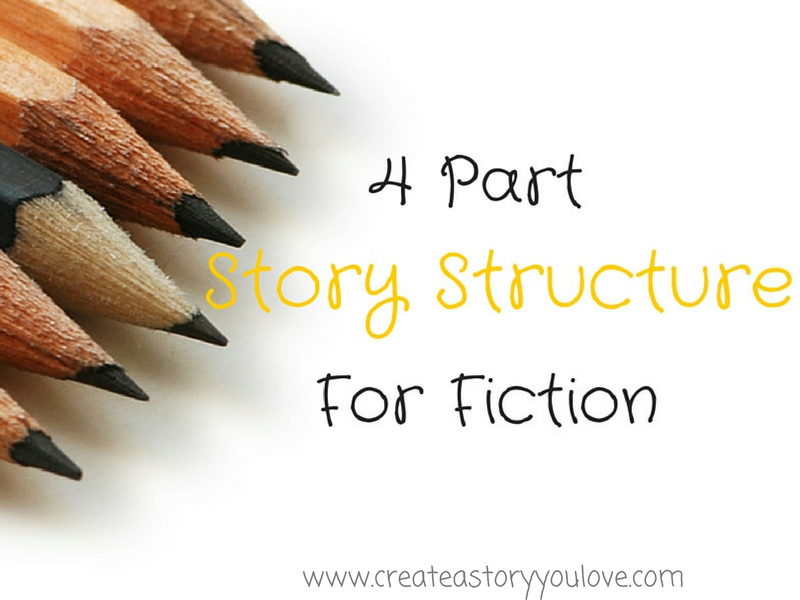A few weeks before NaNoWriMo begins each November, I begin brainstorming ideas for possible novels. I started writing down thoughts the other day on the story structure for my Contemporary Romance Novel.
I’ve been inspired in the past by New York Times bestselling author, Jerry B. Jenkins and lately by a recent podcast interview I had with Steve Windsor, thriller author. They both talk about 4 simple parts to great story structure for your fiction novel.
So, I dived in a little deeper figuring this out for my own novel, in preparation for NaNoWriMo. Here’s what I came up with…

There is a helpful formula – or guide – to write better fiction. Jerry B. Jenkins says that it’s not complicated and it can be easily mastered…. and it makes your job easier and more fun.
This is classic story structure at its best and simple to understand and use.
- The Setup: Put your main character into trouble of some kind and as soon as you can. Whatever the trouble you choose to put your hero in, it needs to appear to overwhelm your lead character from the first page. For the romance that I’m writing right now, my main character Abby, is just graduated from Art College. She’s young, inexperienced and is marrying her best friend since High School. But on her wedding day, tragedy strikes. After being married for only 5 hours, Abby finds herself a widow. Daniel is killed in a motorcycle accident after driving his friend to the airport.
- Reaction: Everything your main character does to try to make things better, actually makes it worse. Whatever problem your main character runs into, has to make sense… to be believable. In my example, Abby is devastated by Daniel’s death and is like a walking zombie. She goes back to live with her parents on their farm, and allows them to coddle and comfort her. But what starts out as comfort turns out to be confining. The last straw is when she talks with her old High School friends at her parents BBQ, and as hard as she tries to get back into the friends group she used to be involved with, but she just doesn’t fit in. Her friends get upset at her and Abby feels pressured to go back to who she used to be. Only problem is, she doesn’t want that. She decides to leave and goes to her grandmother’s old cottage on Mulberry Island(here’s my Pinterest board about Mulberry Island). She spent many summers there as a child and wants to discover who she is again. But also, Daniel’s uncle Gus is the old lightkeeper on the Island. He’s a grumpy old man and when Abby comes around asking to see family photo albums, he gets really mad at her for snooping around. Soon, even the people who have become her friends on the Island, tell her to leave well enough alone. Abby starts to wonder what the big secret is…
- Proaction. The main character tries to fight back, but has to fail. This is where the last worst thing that happened, looks insurmountable. At first Abby is overwhelmed and hides herself away in the old cottage. She starts to try to fix up the house, but it seems like too much. Since Daniel left her some money, she decides to hire a restoration architect. One man is highly recommended especially by old Vi Grantham, the Island’s matriarch. Jack Shepherd. He comes to the Island to have a look, and Abby who was expecting someone a lot older, is surprised by how young and handsome Jack is. She agrees to Jack’s prices and he starts fixing the kitchen. Abby, distracted by Jack’s brooding presence, often leaves the house to go paint at the beach(although if she’d admit it, she’d realize she’s attracted to Jack). It’s as she’s getting to know Jack, that she keeps going back to visit Daniel’s Uncle Gus. One day Daniel’s uncle slams the door in her face, telling her to never come back. Abby is so hurt she runs home and locks herself in her room sobbing. Jack knocks on the door, and asks if he can help her. Of course, this is where the kissing starts. Even though things are going well with Jack, Abby starts pushing Jack away too. She starts to put walls up, especially with the information she found on her last trip home – that Daniel had a baby with another woman before they got married – she feels like she desperately needs to know more about her dead husband.
- Resolution. Your main character succeeds by taking action, based on what he/she has learned about himself/herself in the middle of all the challenges. Abby realizes she can’t change the past, but she discovers in herself a will to win. To figure out a way to fight for the truth and in the meantime learn more about herself too. Sorry, I’ll leave it there so I don’t spoil the ending;)
So that’s the 4 simple steps to classic story structure. I’m not sure I’m doing it justice with my own examples… I’m still working through my plot, but I’m loving learning more about the different characters involved. Coming up with twists on story ideas and digging deeper into character traits is what I love.
I also talk about this story structure in the Free Storyteller’s Roadmap mini-course here.
Of course, there are still some parts of fiction writing that are challenging. One of the more difficult parts of storytelling for me is to make sure I put my main character in to terrible trouble as soon as possible. I’ve been learning that: getting your main character into trouble is key for every great story.
What sort of structure do you use to plan your fiction story? I’d love to hear your thoughts in the comments.
